
SHURE microphone techniques
.pdf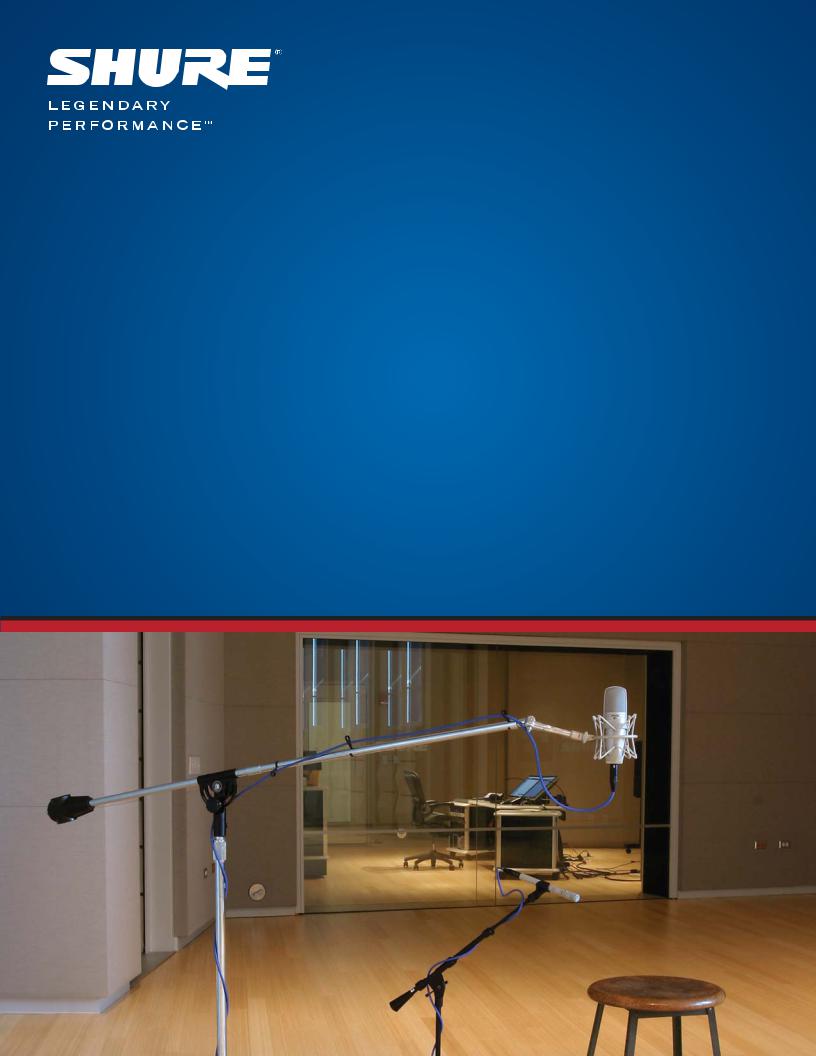
A Shure Educational Publication
MICROPHONE
TECHNIQUES
RECORDING


|
Microphone Techniques |
Ta b l e o f C o n t e n t s |
for RECORDING |
On the cover: Shure’s Performance Listening Center featuring state-of-the-art recording and product testing capabilities. Photo by Frank Dina/Shure Inc.
Internal application photography by Cris Tapia/Shure Inc.
Introduction: Selection and Placement of Microphones |
............. 4 |
Section One .................................................................................. |
5 |
Microphone Techniques ........................................................ |
5 |
Vocal Microphone Techniques ............................................... |
5 |
Spoken Word/“Podcasting” ................................................... |
7 |
Acoustic String and Fretted Instruments ................................ |
8 |
Woodwinds .......................................................................... |
13 |
Brass ................................................................................... |
14 |
Amplified Instruments .......................................................... |
15 |
Drums and Percussion ........................................................ |
18 |
Stereo .................................................................................. |
21 |
Introduction: Fundamentals of Microphones, |
|
Instruments, and Acoustics ....................................................... |
23 |
Section Two ................................................................................ |
24 |
Microphone Characteristics ................................................. |
24 |
Instrument Characteristics ................................................... |
27 |
Acoustic Characteristics ....................................................... |
28 |
Shure Microphone Selection Guide ..................................... |
32 |
Shure Recording Microphone Lockers ................................ |
33 |
Glossary ............................................................................... |
34 |
Appendix A: The Decibel ..................................................... |
37 |
Appendix B: Transient Response ......................................... |
38 |
About the Authors ................................................................ |
39 |
Recording
3

Microphone Techniques
for RECORDING
Introduction
The selection and placement of microphones can have
a major influence on the sound of an acoustic recording.
It is a common view in the recording industry that the music
played by a skilled musician with a quality instrument
properly miked can be sent directly to the recorder with little
or no modification. This simple approach can often sound
better than an instrument that has been reshaped by a
multitude of signal processing gear.
In this guide, Shure Application Engineers describe
particular microphone techniques and placement:
techniques to pick up a natural tonal balance, techniques
to help reject unwanted sounds, and even techniques to
create special effects.
Following this, some fundamentals of microphones,
instruments, and acoustics are presented.
Section One
4

Microphone Techniques
for RECORDING
SECTION ONE
Microphone Techniques
Here is a very basic, general procedure to keep in mind when miking something that makes sound:
1)Use a microphone with a frequency response that is suited to the frequency range of the sound, if possible, or filter out frequencies above and/or below the highest and lowest frequencies of the sound.
2)Place the microphone at various distances and positions until you find a spot where you hear from the studio monitors the desired tonal balance and the desired amount of room acoustics. If you don’t like it, try another position, try another microphone, try isolating the instrument further, or change the sound of the instrument itself. For example, replacing worn out strings will change the sound of a guitar.
3)Often you will encounter poor room acoustics, or pickup of unwanted sounds. In these cases, place the microphone very close to the loudest part of the instrument or isolate the instrument. Again, experiment with microphone choice, placement and isolation, to minimize the undesirable and accentuate the desirable direct and ambient acoustics.
Microphone technique is largely a matter of personal taste. Whatever method sounds right for the particular sound, instrument, musician, and song is right. There is no one ideal way to place a microphone. There is also no one ideal microphone to use on any particular instrument. Choose and place the microphone to get the sound you want. We recommend experimenting with all sorts of microphones and positions until you create your desired sound. However, the desired sound can often be achieved more quickly by understanding basic microphone characteristics, sound-radiation properties of musical instruments, and basic room acoustics.
Vocal Microphone Techniques
Individual Vocals
Microphones with various polar patterns can be used in vocal recording techniques. Consider recording a choral group or vocal ensemble. Having the vocalists circle around an omnidirectional mic allows well trained singers to perform as they would live: creating a blend of voices by changing their individual singing levels and timbres. Two
cardioid mics, positioned back to back could be used for this same application.
An omnidirectional mic may be used for a single vocalist as well. If the singer is in a room with ambience and reverb that add to the desired effect, the omnidirectional mic will capture the room sound as well as the singer’s direct voice. By changing the distance of the vocalist to the microphone, you can adjust the balance of the direct voice to the ambience. The closer the vocalist is to the mic, the more direct sound is picked up relative to the ambience.
The standard vocal recording environment usually captures the voice only. This typically requires isolation and the use of a unidirectional mic. Isolation can be achieved with baffles surrounding the vocalist like a “shell” or some other method of reducing reflected sound from the room. Remember even a music stand can cause reflections back to the mic.
The axis of the microphone should usually be pointed somewhere between the nose and mouth to pick up the complete sound of the voice. Though the mic is usually directly in front of the singer’s mouth, a slightly off-axis placement may help to avoid explosive sounds from breath blasts or certain consonant sounds such as “p”, “b”, “d”, or “t”. Placing the mic even further off-axis, or the use of an accessory pop filter, may be necessary to fully eliminate this problem.
While many vocals are recorded professionally in an isolation booth with a cardioid condenser microphone, other methods of vocal recording are practiced. For instance, a rock band’s singers may be uncomfortable in the isolated environment described earlier. They may be used to singing in a loud environment with a monitor loudspeaker as the reference. This is a typical performance situation and forces them to sing louder and push their voices in order to hear themselves. This is a difficult situation to recreate with headphones.
A technique that has been used successfully in this situation is to bring the singers into the control room to perform. This would be especially convenient for project studios that exist in only one room. Once in that environment, a supercardioid dynamic microphone could be used in conjunction with the studio monitors. The singer faces the monitors to hear a mix of music and voice together. The supercardioid mic rejects a large amount of the sound projected from the speakers if the rear axis of the microphone is aimed between the speakers and the speakers are aimed at the null angle of the mic (about 65 degrees on either side of its rear axis). Just as in live sound, you are using
5
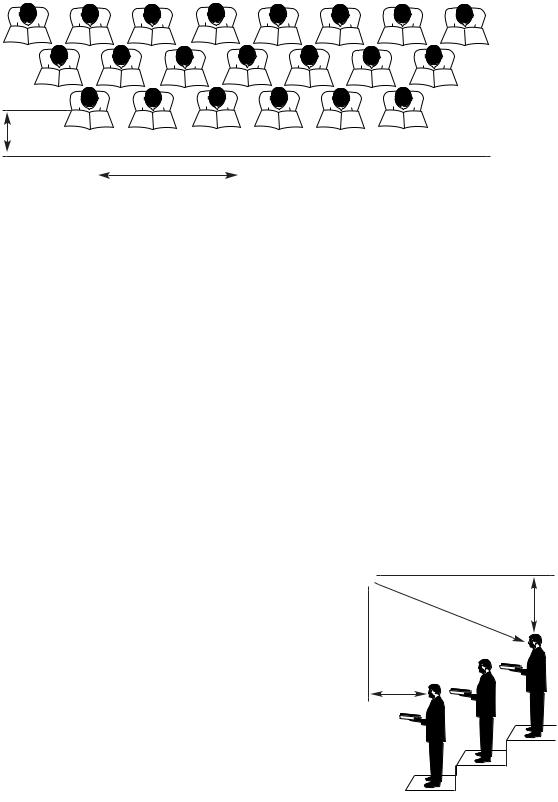
Microphone Techniques
for RECORDING
0.6 - 1m (2 - 3 ft)
1.8 - 3m
(6 - 9 ft)
Choir microphone positions - top view
the polar pattern of the mic to improve gain-before-feedback and create an environment that is familiar and encouraging to the vocalists. Now the vocalist can scream into the late hours of the night until that vocal track is right.
Ensemble Vocals
A condenser is the type of microphone most often used for choir applications. They are generally more capable of flat, wide-range frequency response. The most appropriate directional type is a unidirectional, usually a cardioid. A supercardioid or a hypercardioid microphone may be used for a slightly greater reach or for more ambient sound rejection. Balanced low-impedance output is used exclusively, and the sensitivity of a condenser microphone is desirable because of the greater distance between the sound source and the microphone.
Application of choir microphones falls into the category known as “area” coverage. Rather than one microphone per sound source, the object is to pick up multiple sound sources (or a “large” sound source) with one (or more) microphone(s). Obviously, this introduces the possibility of interference effects unless certain basic principles (such as the “3-to-1 rule”) are followed, as discussed below.
For one microphone picking up a typical choir, the suggested placement is a few feet in front of, and a few feet above, the heads of the first row. It should be centered in front of the choir and aimed at the last row. In this configuration, a cardioid microphone can “cover” up to 15-20 voices, arranged in a rectangular or wedge-shaped section.
For larger or unusually shaped choirs, it may be necessary to use more than one microphone. Since the pickup angle of a microphone is a function of its directionality (approximately 130 degrees for a cardioid), broader coverage requires more distant placement.
In order to determine the placement of multiple microphones for choir pickup, remember the following rules: observe the 3-to-1 rule (see glossary); avoid picking up the same sound source with more than one microphone; and finally, use the minimum number of microphones.
For multiple microphones, the objective is to divide the choir into sections that can each be covered by a single microphone. If the choir has any existing physical divisions (aisles or boxes), use these to define basic sections. If the choir is grouped according to vocal range (soprano, alto, tenor, bass), these may serve as sections.
If the choir is a single, large entity, and it becomes necessary to choose sections based solely on the coverage of the individual microphones, use the following spacing: one microphone for each lateral section of approximately 6 to 9 feet. If the choir is unusually deep (more than 6 or 8 rows), it may be divided into two vertical sections of several rows
each, with aiming angles
adjusted
accordingly. In any case, it is better to use too
few microphones
than too many. In a good-
sounding space, a pair of microphones in a stereo configuration can provide realistic reproduction. (See page 22.)
6
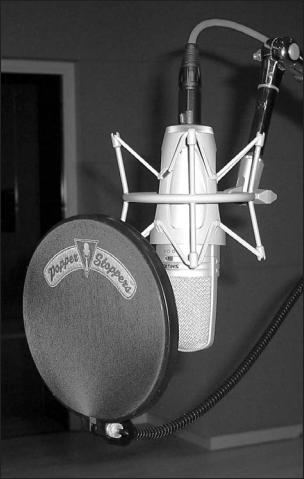
Microphone Techniques
for RECORDING
Spoken Word/ “Podcasting”
Countless “how-to” articles have been written on podcasting, which is essentially a current trend in spoken word distribution, but few offer many tips on how to properly record the human voice. Below are some suggestions:
1.Keep the microphone 6 –12” from your mouth.
Generally, keep the microphone as close as possible to your mouth to avoid picking up unwanted room reflections and reverberation. Do not get too close either. Proximity effect, which is an increase in low frequency response that occurs as you get closer to a directional microphone, can cause your voice to sound “muddy” or overly bassy.
2.Aim the microphone toward your mouth from below or above.
This placement minimizes “popping” caused by plosive consonants (e.g. “p” or “t”).
3.Use an external pop filter.
Though most microphones have some sort of builtin windscreen, an additional filter will provide extra insurance against “p” pops. The pop filter can also serve as a reference to help you maintain a consistent distance from the microphone. (See Image 1.)
4.Keep the microphone away from reflective surfaces.
Reflections caused by hard surfaces, such as tabletops or music stands, can adversely affect the
sound quality captured by the microphone. (See the |
Image 1: Example of an external pop filter |
section “Phase relationships and interference |
|
effects” page 30.) |
|
5.Speak directly into the microphone.
High frequencies are very directional, and if you turn your head away from the microphone, the sound captured by the microphone will get noticeably duller.
7
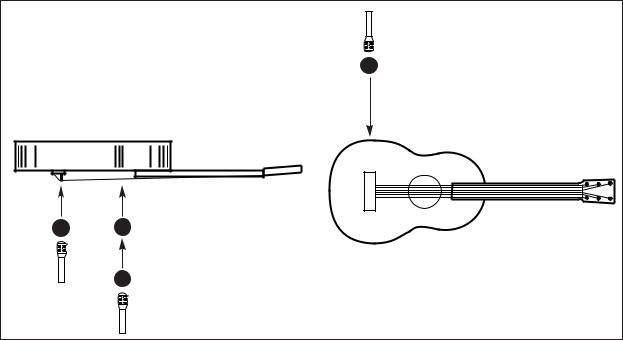
Microphone Techniques
for RECORDING
Acoustic String and Fretted Instruments
Experimentation with mic placement provides the ability to achieve accurate and pleasing sound reproduction on these complex sound sources. It is also an opportunity for exploring sound manipulation, giving the studio engineer many paths to the final mix. Whether you are involved in a music studio, a commercial studio, or a project studio, you should continue to explore different methods of achieving the desired results. The possibilities are limited only by time and curiosity.
Acoustic Guitar (Also Dobro, Dulcimer, Mandolin, Ukelele)
When recording an acoustic guitar, try placing one mic three to six inches away, directly in front of the sound hole. Then put another microphone, of the same type, four feet away.
This will allow you to hear the instrument and an element of room ambience. Record both mics dry and flat (no effects or EQ), each to its own track. These two tracks will sound vastly different. Combining them may provide an open sound with the addition of the distant mic. Giving the effect of two completely different instruments or one in a stereo hallway may be achieved by enhancing each signal with EQ and effects unique to the sound you want to hear.
Try the previously mentioned mic technique on any acoustic instrument. Attempt to position the mic in different areas over the instruments, listening for changes in timbre. You will find different areas offer different tonal characteristics. Soon you should develop “an ear” for finding instruments’ sweet spots. In addition, the artist and style of music should blend with your experiences and knowledge to generate the desired effect.
|
Above |
Front |
|
|
4 |
|
|
6” |
3 |
2 |
|
|
1 |
|
Various microphone positions for acoustic guitar
8
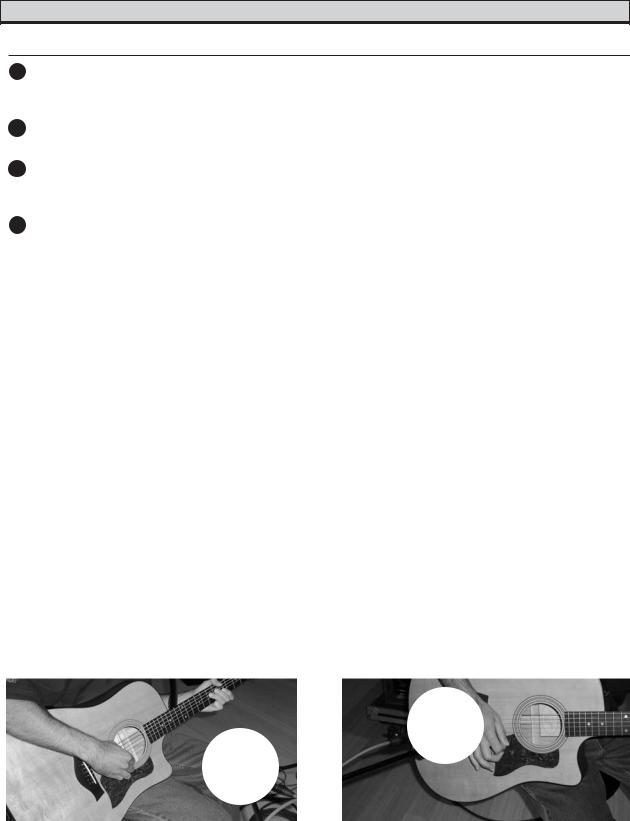
Microphone Techniques
for RECORDING
Microphone Placement Tonal Balance Comments
Acoustic Guitar:
1 8 inches from sound hole |
Bassy |
Good starting placement when leakage is a |
(see image 2) |
|
problem. Roll off bass for a more natural |
|
|
sound (more for a uni than an omni). |
2 3 inches from sound hole |
Very bassy, boomy, |
Very good isolation. Bass roll-off needed |
|
muddy, full |
for a natural sound. |
3 4 to 8 inches from bridge |
Woody, warm, |
Reduces pick and string noise. |
(see image 3) |
mellow. Mid-bassy, |
|
|
lacks detail |
|
4 6 inches above the side, over |
Natural, |
Less pickup of ambiance and leakage |
the bridge, and even with the front |
well-balanced, |
than 3 feet from sound hole. |
soundboard |
slightly bright |
|
Miniature microphone clipped |
Natural, |
Good isolation. Allows freedom of |
outside of sound hole |
well-balanced |
movement. |
Miniature microphone clipped |
Bassy, less |
Reduces leakage. Test positions to find |
inside sound hole |
string noise |
each guitar’s sweet spot. |
Banjo: |
|
|
|
|
|
3 inches from center of head |
Bassy, thumpy |
Limits leakage. Roll off bass for natural sound. |
3 inches from edge of head |
Bright |
Limits leakage. |
Miniature microphone clipped to |
Natural |
Limits leakage. Allows freedom of movement. |
tailpiece aiming at bridge |
|
|
Violin (Fiddle): |
|
|
A few inches from side |
Natural |
Well-balanced sound. |
Cello: |
|
|
|
|
|
1 foot from bridge |
Well-defined |
Well-balanced sound, but little isolation. |
All String Instruments: |
|
|
|
|
|
Miniature microphone attached to |
Bright |
Minimizes feedback and leakage. |
strings between bridge and tailpiece |
|
Allows freedom of movement. |
Image 2: Acoustic guitar position 1 |
Image 3: Acoustic guitar position 3 |
9 |
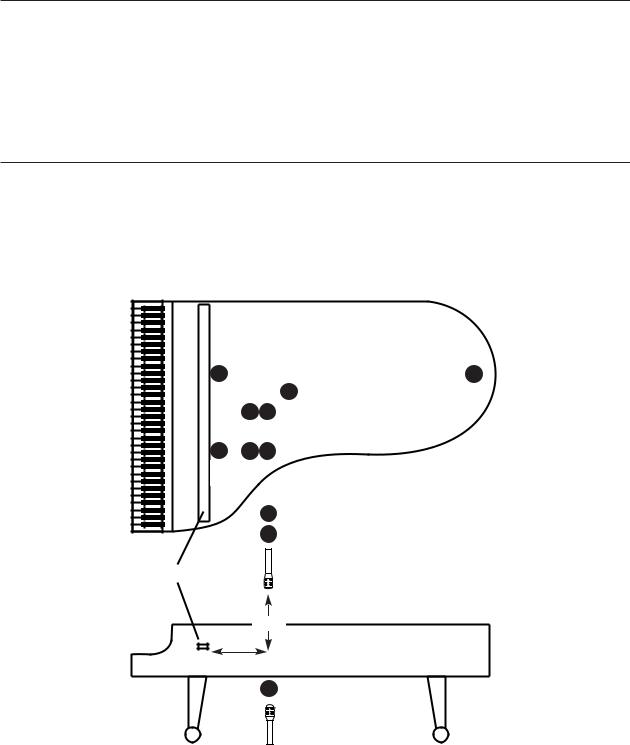
Microphone Techniques
for RECORDING
Microphone Placement |
Tonal Balance |
Comments |
|
|
|
Acoustic Bass: (Upright Bass, String Bass, Bass Violin)
6 inches to 1 foot out front, just above bridge
A few inches from f-hole
Wrap microphone in foam padding (except for grille) and put behind bridge or between tailpiece and body
Well-defined |
Natural sound. |
Full |
Roll off bass if sound is too boomy. |
Full, “tight” |
Minimizes feedback and leakage. |
Harp:
Aiming toward player at part of soundboard, about 2 feet away
Tape miniature microphone to soundboard
Natural |
See “Stereo Microphone Techniques” |
|
section for other possibilities. |
Somewhat |
Minimizes feedback and leakage. |
constricted |
|
Grand Piano
8 |
9 |
5
1 4
8 7 2
1
4
Hammers
6”-12”
8”
6
10
